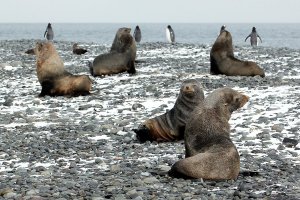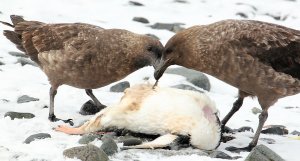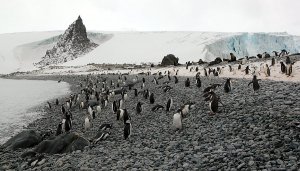Arto's Blog
| « Antarctic bathing | First time on open sea » |
Penguins, seals, lots of penguins
Posted: 2015-07-13 21:45:00, Categories: Travel, Antarctica, Sailing, 875 words (permalink)When we woke up and climbed up on the deck on the sixth day after
leaving Ushuaia, we saw a landscape of rock, snow and ice with a row
of penguins at the nearest shore. It was the Yankee Harbor at South
Shetland islands, where we had arrived late previous night when it
was already dark. We were at anchor and there were almost no waves
so our seasickness was quickly gone. After breakfast and a short
briefing by our guides Jordi and Eduardo, the zodiacs were launched
and we were ready for our first landing.
As soon as we stepped on land, we were surrounded by more animals
we had ever seen in any zoo — and here they were all in their
natural surroundings. One of our first tasks was to learn how to
deal with slightly aggressive fur seals. Here's the tactic: don't
run, stop and raise your hands, try to look as big and dangerous as
possible. That was enough to stop the attacks, after all the seals
just wanted to guard their own space on the beach and were not
otherwise interested in us. Most of the seals were calmly scratching
themselves, sleeping or busy with other activities.
We enjoyed watching gentoo penguins going in and out of water,
marching around and lying in the snow in various positions. It was
late in the season and many had already left the colony, but there
were still many adults and almost grown up chicks around. We also
saw one chinstrap penguin in the middle of all the gentoos, a
leopard seal and a Weddell seal. The cruel side of nature was also
present: some penguins had not made it and were lying dead and
frozen on the ground. Two skuas were having a feast on one of the
bodies.
We came back to the ship for lunch, carefully cleaning and
desinfecting our boots which was the standard procedure before and
after each landing. The aim was to avoid introducing any foreign
organic material in the Antarctic, and to avoid spreading diseases
between different landing sites. During our lunch, the captain
turned on the engines to move the ship to Fort Point, the site of
our second landing of the day.
At Fort Point there were again lots of wildlife, mostly gentoo
penguins and fur seals but also some chinstrap penguins and one
solitary macaroni penguin. Our guides told us that Fort Point was
one of the less frequented landing sites, perhaps therefore the
penguins were coming even closer to us than at Yankee Harbor. As a
general rule we were instructed to keep 5 meters distance to all
animals, but sometimes they came closer to us. We climbed up the
hill away from the shore to a "nunatak" a steep and high
rock with a glacier flowing around it. From the nunatak we had a
gorgeous view down to the peninsula. On one side of it, countless
ice pieces were being washed to the shore, a clear indication that
the water temperature was very close to the freezing point.
The following day we visited Deception island, which is actually
the remains of a large ancient volcano. In a big eruption the main
crater collapsed and sank, so the the island is like a giant horse
shoe with a narrow entrance to the big sheltered bay in the middle.
Some fresh snow had recently fallen on the dark volcanic ash, which
made the landscape full of different patterns of black and white.
During our first landing we walked around one of the side craters
and admired the views. Unfortunately the weather was cloudy, on a
sunny day the scenery would have been even more spectacular.
The second landing was a few kilometers walk over the rim to a
point called Baily Head. On the top of the ridge we could see the
shape of the island and the entrance through which we had entered
the caldera. On the other side of the ridge near the sea, the snowy
slopes were looking like they were dirty.
As we came closer it
became apparent that the "dirt" was tens of thousands of
chinstrap penguins. Many of them were moulting, renewing their fur
which they do every year. We spent quite a while watching and
listening to the constant chatter of the penguins before heading
back the same way we came. Thanks to Jordi we had a chance to take a
look at the penguins through a 600 mm lens, 960 mm film equivalent
when mounted to our camera.
Before returning to the ship we still had time to visit the ruins of an old whaling station, consisting of slowly rusting big tanks which had been used to store whale oil and a group of more or less collapsed wooden houses. After that it was time for dinner and a special evening activity, which will be described in the next post.
No feedback yet

Copyright Arto Teräs <ajt@iki.fi>, licensed under the Creative Commons Attribution-Share Alike 3.0 Unported License. (Unless otherwise mentioned in individual photos or other content.)







